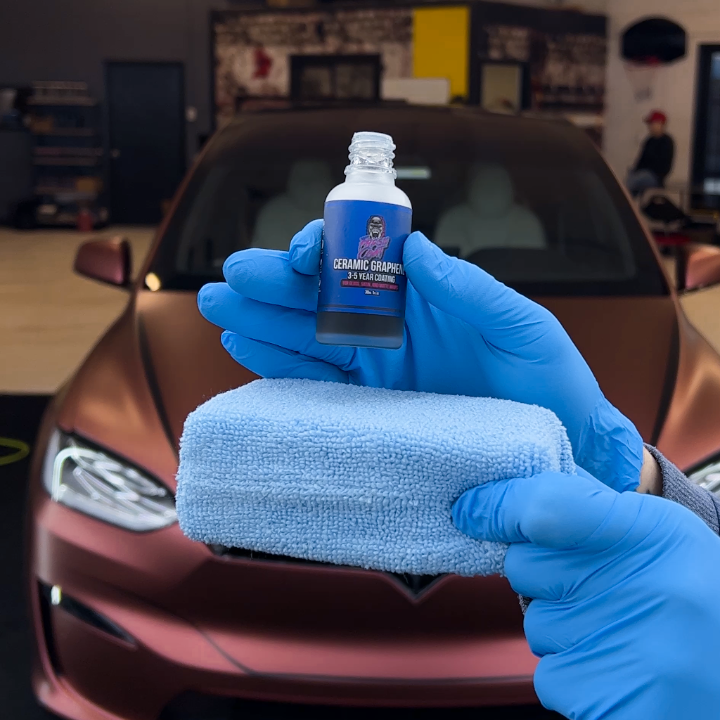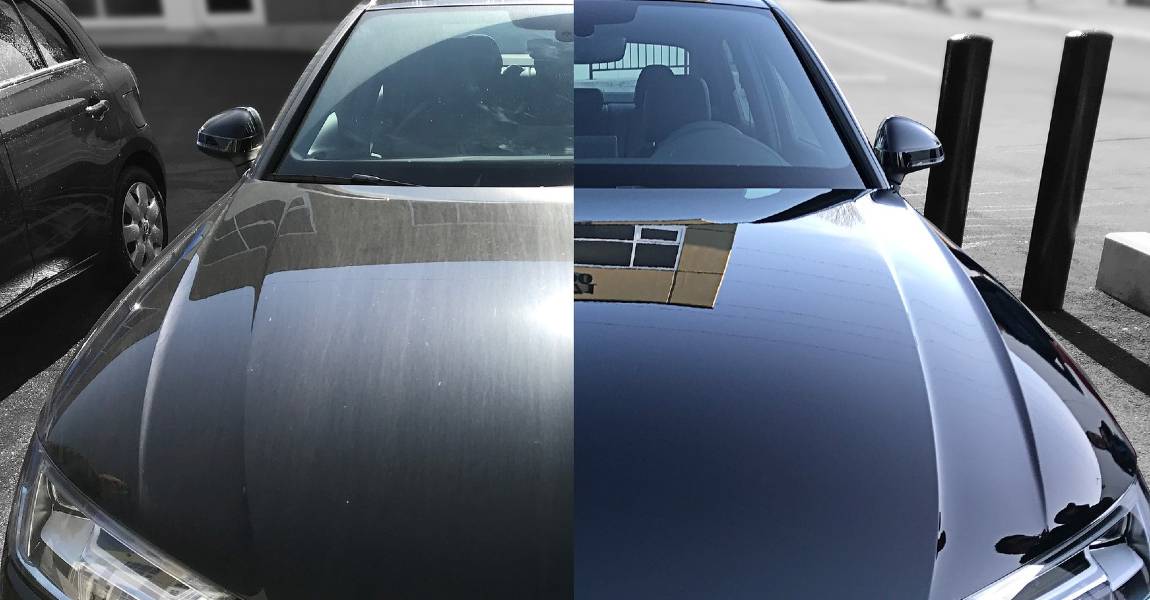The Ultimate Guide to Ceramic Coating: Benefits and Application Methods
The Ultimate Guide to Ceramic Coating: Benefits and Application Methods
Blog Article
Understanding the Science Behind Ceramic Coating for Enhanced Car Toughness
The scientific research of ceramic layer is revolutionizing car maintenance by offering a formidable shield against harsh environmental factors. At its core, this technology harnesses the power of silicon dioxide and titanium dioxide to form a durable, protective layer. What specifically makes these substances so efficient in protecting a car's exterior? As we explore the detailed make-up and application procedure of ceramic finishings, we discover the secrets behind their superior defense and durability. Exactly how does this compare to typical approaches, and what ramifications does it have for car upkeep in the lengthy term? The responses may stun you.

Make-up of Ceramic Coatings
Ceramic finishings are mostly made up of silicon dioxide (SiO2), which is derived from all-natural products like quartz and sand. In addition to SiO2, ceramic finishings often integrate titanium dioxide (TiO2) for boosted UV security and increased resistance to environmental contaminants.
The formula of ceramic layers is a meticulous process where the concentration of SiO2 can substantially affect the finish's efficiency. Greater SiO2 web content commonly results in greater resilience and hardness, adding to the coating's ability to resist scrapes and chemical etching. The equilibrium of parts is important; too much SiO2 can make the coating weak, while also little can jeopardize its protective residential or commercial properties.
Producers may additionally incorporate extra substances, such as polysilazane, to boost versatility and simplicity of application. These additives improve the layer's hydrophobic buildings, making certain water and pollutants bead off the surface area effortlessly. This engineered make-up highlights the efficacy of ceramic layers in securing a car's outside against a selection of negative conditions.
Application Refine Discussed
Using a ceramic finishing to a vehicle entails several essential steps, each vital to making certain optimal attachment and performance of the safety layer - ceramic coating. The process begins with a thorough laundry and decontamination of the automobile's surface area to eliminate dust, grime, and previous waxes or sealers. This action is essential as any pollutants left externally can impede the coating's capability to bond properly
Following the preliminary cleansing, the next step entails polishing the vehicle to get rid of any kind of imperfections, such as swirl marks or scratches. Sprucing up ensures a smooth surface, which is crucial for the coating to adhere appropriately and give an uniform surface. After brightening, a surface area preparation spray is used to eliminate any type of continuing to be deposits and ensure that the surface is completely tidy.

Protective Advantages
Typically hailed for its remarkable safety qualities, a ceramic layer offers many advantages that considerably improve vehicle sturdiness. At its core, ceramic layer forms a hard, semi-permanent barrier over an automobile's outside, which acts as a shield against different ecological threats.
Moreover, ceramic finishings display hydrophobic properties, implying they push back water and promote a self-cleaning result. This attribute decreases the adherence of dirt and mud, simplifying upkeep and cleansing procedures. The finish's resistance to chemical etching better ensures that the car's surface stays unblemished regardless of direct exposure to rough cleansing representatives and toxins.
Along with these safety advantages, the ceramic coating enhances a vehicle's aesthetic appeal by creating a shiny coating that emphasizes shade deepness and clearness. This not only sustains the vehicle's visual allure yet additionally contributes to its lasting worth by maintaining the stability of its exterior in time.
Comparing to Traditional Approaches
Unlike typical techniques of automobile security, such as waxing or sealers, ceramic layers use a more durable and long lasting option. Where waxes and sealants typically give a momentary layer of security, often calling for reapplication every couple of months, ceramic coverings create a semi-permanent bond with the automobile's paint. This bond creates a safety layer that is resistant to environmental impurities, UV damage, and small abrasions.
Conventional waxes are primarily made up of natural parts like carnauba wax, offering a shiny surface yet lacking the durable protective top qualities of ceramic layers. Sealants, while artificial and offering slightly better resilience than waxes, still drop short in contrast to the strength and chemical resistance of ceramic finishings. The check my source advanced innovation of ceramic coatings integrates nanotechnology, which permits them to fill out tiny imperfections in the paint surface area, resulting in a smoother and a lot more hydrophobic coating.
In terms of application, ceramic finishes require a more careful process, typically demanding professional setup to make certain optimal performance. This contrasts with the reasonably straightforward application of sealants and waxes, which can be applied in your home. The remarkable defense and visual enhancement offered by ceramic finishes warrant the investment for those seeking long-term car preservation.
Durability and Upkeep
Just how does the long life of ceramic coatings translate into ease of maintenance for car owners? The sophisticated formula of ceramic finishings supplies a durable safety layer on the automobile's surface area, which substantially prolongs the life expectancy of the cars and truck's outside surface. This toughness indicates that the layer works as a guard versus environmental contaminants such as UV rays, bird droppings, and road grime, which can or else weaken paintwork gradually. Consequently, automobiles coated with ceramic products call for much less regular cleaning and outlining efforts, thereby lowering upkeep time and expenses for owners.
Additionally, the hydrophobic nature of ceramic finishings enables water and various other liquids to grain up and roll off the surface, lugging dirt and particles with them. This property decreases the accumulation of impurities, making routine cleaning a lot more efficient and much less labor-intensive. Owners benefit from a regularly smooth, glossy appearance with marginal effort. While the layer itself is lasting, it is not totally maintenance-free. Regular assessments for damages and occasional reapplication are advised to ensure the protective layer continues to be intact. Therefore, ceramic layers offer a beneficial balance between long-lasting resilience and streamlined upkeep for vehicle care.
Conclusion
Ceramic layers, with their advanced chemical make-up of silicon dioxide and titanium dioxide, give an awesome obstacle versus environmental damage, significantly enhancing lorry durability. The hydrophobic residential or commercial properties promote Learn More Here self-cleaning, lowering upkeep initiatives and protecting aesthetic allure. When contrasted to conventional methods, ceramic coverings offer premium security against UV rays, oxidation, and chemical etching. This innovation extends the lifespan of lorry exteriors, making it an innovative solution for lasting preservation and minimal maintenance.
The formulation of ceramic layers is a precise procedure where the concentration of SiO2 can substantially influence the finish's performance.Using a ceramic coating to a car entails a number of essential steps, each crucial to guaranteeing optimum adhesion and performance of the safety layer.Often hailed for its outstanding protective high qualities, a ceramic finish offers various advantages that significantly enhance automobile longevity. The advanced formula of ceramic layers provides Visit Website a robust protective layer on the automobile's surface area, which dramatically extends the lifespan of the automobile's outside coating.Ceramic coatings, with their advanced chemical composition of silicon dioxide and titanium dioxide, offer a powerful obstacle versus ecological damages, substantially boosting lorry durability.
Report this page